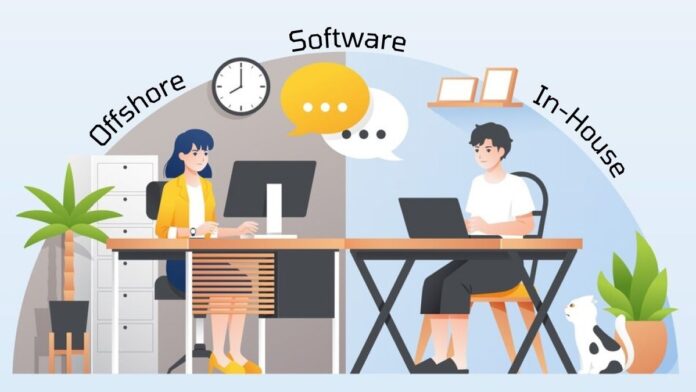Working well with in-house teams and offshore software testing teams to complete successful software projects is essential in today’s globalized world. 🌍 To access specialized skills and cost-effective solutions, many companies turn to offshore teams like software testing firms in India. 🇮🇳 In-house teams also bring a deep understanding of project goals, client expectations, and business needs. 🎯💼
It’s crucial to ensure that both teams are working together smoothly. 🤝 This requires clear communication 💬, clearly defined roles 📝, and an organized workflow. 🔄 This will help avoid issues such as overlapping tasks 🔀 and missing deadlines. ⏳🚫 This blog will look at easy ways to improve the collaboration between onshore and in-house teams. 🌐 We’ll also discuss how to create efficient workflows ⚙️, set up clear responsibilities ✅ and use effective communication tools 📱💻.
Defining Roles for Effective In-House and Offshore Team Collaboration
At the core of any successful collaboration lies the necessity of setting forth clear roles and responsibilities for every team – in-house or offshore. In-house teams may possess superior knowledge about a project’s overall goals, business objectives and client requirements as well as accessing subject matter experts and decision makers within an organization quickly and directly.
Offshore teams such as software testing company in India provide specialized skills, scalability and cost-effective solutions to testing needs. They can take on specific testing tasks to ensure comprehensive and systematic coverage – something which may become an issue when roles and responsibilities are unclear or roles not clearly allocated; to reduce this risk a shared understanding of testing process from planning through reporting and analysis should be developed to eliminate duplication of effort or gaps in coverage risks.
Developing an efficient workflow begins with clearly outlining which types of testing each team will undertake, in order to reduce potential overlap or gaps in coverage and ensure that every member understands their role and what is expected from them. Doing this provides structure necessary for seamless workflows, efficient resource utilization, and the successful execution of software projects – as well as strengthening collaborative efforts among teams for more productive and harmonious relationships between them all.
Also Read – Key Element of Enterprise Data Management
Improving Team Collaboration with Communication Tools
Effective collaboration relies on effective communication. For optimal workflow, teams should adopt tools such as Slack or Microsoft Teams which facilitate daily standup meetings, discussions of any impediments to progress, and real-time updates regarding project progress. Such continuous dialogue allows teams to remain aligned across geographical locations while prompting issue resolution, encouraging idea exchange, and aligning themselves with project’s overarching goals.
➣ Centralized Tracking System
Popular tools like Jira can make adoption of centralized defect tracking systems significantly more collaborative, offering in-house and offshore teams alike access to one centralized platform where bugs are reported, commented upon, assigned and tracked efficiently. By eliminating multiple tools or spreadsheets used for tracking progress of projects across stakeholders’ lives all stakeholders gain an accurate overview of project statuses at any time.
➣ Joint Planning and Estimations
Effective collaboration begins during the planning stage. Both in-house and offshore software testing companies in India should work collaboratively to estimate timelines and plan test cases and scenarios, in order to align expectations from the very start of a project. By jointly determining project scope and timelines, potential misunderstandings are avoided while both teams share an overall vision for its progression.
➣ Consistent Documentation
Consistency is of the utmost importance in collaboration, so in order to avoid communication issues stemming from differences in formatting or documentation styles, it’s crucial that standardized documentation formats be established and adhered to – these formats should include materials like test plans, test cases and reports and guarantee no miscommunication between in-house and offshore teams caused by differences in documentation styles or formatting styles.
➣ Pair Testing Sessions
For complex or exploratory testing, consider pairing in-house and offshore testers together in collaborative sessions. Not only will this give your testing efforts new perspectives, but knowledge sharing among teams also strengthens relationships and increases efficiencies. Collaboration also provides the platform for sharing best practices, solving complex problems more efficiently, as well as making sure testing efforts meet requirements set forth by your project.
➣ Cultural Training
Onboarding programs play a pivotal role in helping offshore testers integrate smoothly into projects. By understanding client work culture, processes, and communication preferences; onboarding programs serve as an avenue for offshore team members to adapt quickly to in-house team practices and expectations – providing organizations with assurances that offshore team members have all they need for effective contributions on projects.
➣ Time Zone Planning
Maximizing working hours between an in-house team and an offshore software testing company in India is critical for effective collaboration. By taking into account different time zones when scheduling testing sprints and tasks, teams can reduce communication delays while keeping projects on schedule with no disruptions to project momentum.
➣ Regular Feedback Loops
Frequent feedback is key to successful collaboration. Both in-house and offshore teams should actively seek feedback on the effectiveness of their efforts, so as to continue improving over time. By addressing issues and fine-tuning efforts for maximum harmony and productivity.
Also Read – What is Mobile Device Management MDM
Conclusion
These best practices will allow in-house software testing companies 🏢 and offshore testing companies 🌍 to work together seamlessly during all phases of testing. It not only increases the efficiency of software projects, but it also maximizes the benefits from distributed resources…💻 The synergy of in-house teams and offshore teams is crucial to the success of projects in an increasingly globalized world.🤝
Thanks for Reading 🖤


